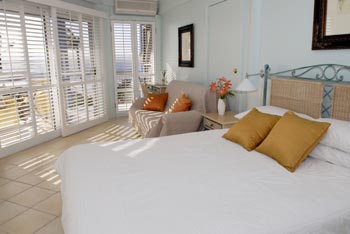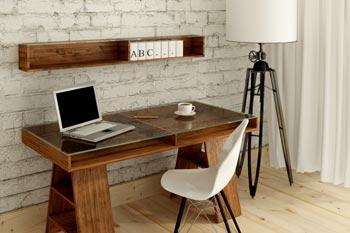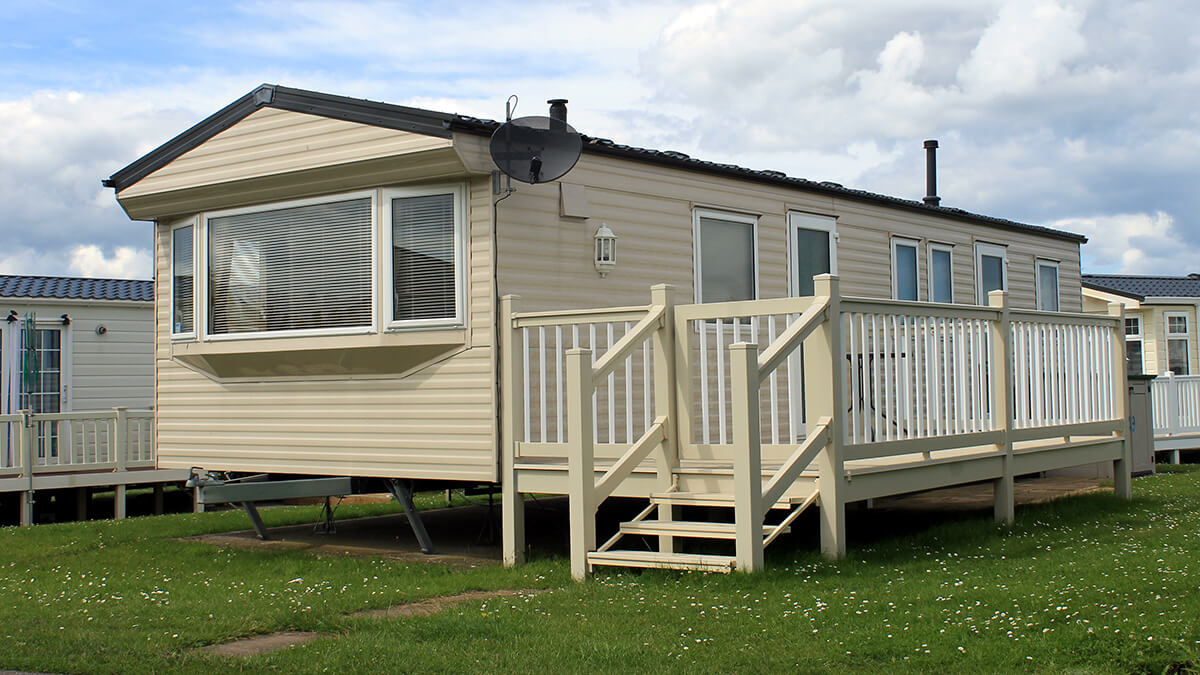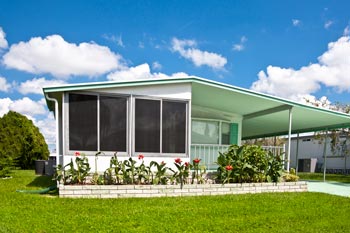Window treatments

Today's window treatments represent a smart new simplicity. Simple doesn't mean plain, but does suggest a crisper, cleaner approach for your manufactured home windows. Giving your windows a fresh look is easier than ever thanks to an astonishing array of high-tech shutters, shades, blinds, fabrics and decorative hardware in all sorts of colors, styles and finishes.
Before choosing from the wide selection of new design possibilities, determine the function of each window and what you want the window treatment to do. Consider privacy, light control, ventilation, the view and energy efficiency when selecting a covering for any window in your home.
Keep in mind that a well designed window treatment suits not only the window, but also blends with the rest of the room and adds to the sense of unity. Here are a few suggestions to help you update and beautify your windows.
Measuring Windows
Take all measurements using a retractable steel tape measure. Unlike cloth tape, it won't sag and will give you more accurate results. Measure each window separately and record the measurements on paper.
Before measuring, decide whether you want to mount the window treatments inside or outside the window opening. You can mount valances, shades or blinds either outside or inside, while cornices look best when mounted on the outside of a window frame.
For window treatments mounted inside the window, you need only measure the width and length of the opening. Measure the width at the top, middle and bottom of the frame and use the narrowest measurement. Measure the height of the window from the top of the opening to the sill. Make the space between the window and the frame deep enough to accommodate any hardware you might be using.
Extend the measurement for outside mounted shades or blinds at least two inches beyond the window sash on each side. Measure the window frame width plus the overlap needed for mounting hardware on either side of the frame. And measure from outside the top of the frame to the sill and add the height of the mounting brackets if they'll be mounted above.
To choose the right rod length, measure from bracket to bracket. For a decorative pole with finials, add 5 to 8 inches on each side depending on the size of the finials. Make sure there is enough room on either side of the window before buying the pole and finials.

Savvy Shutters
You can use interior window shutters in any room in your manufactured home and seldom need a fabric valance or drapery to dress them up. They are attractive, help regulate light, insulate and fit into almost any décor due to their simplicity and clean lines. Although available in numerous colors and stains, shutters look best when painted or finished the same as the rest of the window frame.
You can mount them inside or outside the window frame. If you are doing the installation yourself, use an outside mount to make installation easier. Leave room to swing open or fold back the shutter panels.
Choose from many shutter styles:
- Traditional shutters with l-l/4 inch movable louvers
- Plantation shutters with wider louvers ranging from about 2-l/2 to 4-l/2 inches wide
- Café shutters make a good choice if you want to cover just the lower half of a window. Double-hung tiered sets can cover a window completely, giving you more ways to regulate light and privacy.
- Wood shutters offer a greater selection of louver widths, frame styles, stains or colors, but are usually more expensive than vinyl.
- Quality vinyl shutters provide a practical option. They are easier to clean, moisture resistant and won't crack, peel, fade or deteriorate like wood, although color selection is usually limited to white or ivory.
Trendy Shades and Blinds
You can display today's beautiful shades and blinds alone, pair with a valance or combine with drapery panels of varying lengths and styles. High-tech styles and materials leave no shortage of choices. Because they often share materials, it's sometimes difficult to distinguish between shades and blinds, so here's a brief description of some of the most popular types.
Roman Shades
- made of woven fabric that looks and feels like drapery
- can be raised or lowered like a blind
- features loosely folded, horizontal pleats usually 4 to 6 inches deep
- available in flat-fold or teardrop styles
- ready-made in a variety of colors and materials
Pleated Shades
- stack compactly above window for maximum view
- pleats are usually one inch
- hide completely under curtains when fully raise
- available in various colors, textures and fabric styles, including faux marble, paper, antique satin and lace
- for a clean look use a solid color or tone-on-tone patterns
Honeycomb (Cellular) Shades
- layers of fabric are pleated accordion-style in honeycomb shapes
- available in single, double and triple cell designs
- air-cushioned fabric layers provide exceptional insulatio
- new honeycomb shades have no exposed cords
- pleats range in size from 3/8 inch to 2 inches
Woven-Wood Shades
- made from bamboo, matchsticks, hemp, jute, woven reeds, grasses and other natural or natural-looking materials
- require more stacking space than pleated or honeycomb styles
Venetian (Horizontal) Blinds
- wide assortment of colors
- sizes from l-inch mini-blinds and l/2-inch micro blinds to 2-inch aluminum macro blinds
- stack compactly above window
Vertical Blinds
- made from fabric, vinyl and wood
- opened by simply rotating the vanes
- great for sliding patio doors, picture windows or any other large window
- stack compactly to the sid
- vertical slats or vanes are usually 3-l/2 inches wide
Terrific Toppers
Add versatility to your decorating and use a top treatment to complement your window. Use toppers alone on an uncovered window or combine with shades and blinds to create a simple, uncluttered window fashion. Popular toppers like valances, cornices, swags and scarves can add softness, color or pattern to a room.
Valances
- simplest window treatment
- rectangular fabric that is flat, pleated or gathered
- hung from a rod, pole or board
- ready-made valances are available
- styles include tabbed tops or bottoms that are arched, scalloped, pointed or puffed
Cornices
- usually shallow, rigid boxlike frames
- installed across the top of your window and mounted outside the window frame
- built of wood, molded polystyrene and other lightweight materials
- ready-made cornices are available in several widths and heights
- customize a cornice by adding paint, wallpaper, fabric or rubber-stamp impressions
Swags
- made from several pieces of unlined or lined fabric that join together
- pieces of fabric usually do not exceed 40 inches in width and the drop usually ranges from 12 to 20 inches
- fabric wraps around or drapes over a decorative rod
- can be tied back at the top corners of the window with decorative brackets
- often paired with blinds, shades or shutters
Scarves
- single piece of lightweight fabric that looks the same on the back and front sides
- generous length of fabric usually wraps loosely around rod or pole
- draped fabric can also be held in place with decorative brackets
Hanging a Scarf or Swag
You can drape scarves and swags through rings, sconces, tiebacks, or wrap around a decorative rod or pole. They look great in many different lengths – framing a window, halfway down a window or all the way to the floor. All you need is a generous length of fabric, the correct hardware and the patience to pull and primp until you get the right look:
- It's easier to arrange a scarf or swag if you softly pleat the material lengthwise, accordion-style and pin the pleats at the two points where you want the fabric to drop down the sides of the window.
- Place the fabric over a pole or thread it carefully through the brackets. Decorative brackets, often referred to as scarf holders or sconces, secure the fabric at the top corners of your window.
- Pull the lower pleats in the center of the swag to create an even drape.
- Release the pins, stand back and make any adjustments to the arrangement.

Decorative Hardware
Today's decorative hardware can easily become a focal point for contemporary window fashions. You'll find all kinds of appealing, useful and affordable decorative items, such as rods, poles, finials, scarf holders, holdbacks, rings, clips and pins.
Use decorative hardware to give the finishing touch to your window and your room. For example, you can pair wrought iron, brass or pewter rods with decorative brackets and finials to compliment any décor. Enhance top treatments such as swags and scarves with stunning swag holders that pull the entire window treatment together.
For accessory ideas that will top off your window treatments, explore stores, look at model homes, check out catalogs and surf the Web. You'll find hundreds of window accessories to choose from so you can take full advantage of the windows in your manufactured home. Just make sure you have enough wall room to display your hardware and that your window frames and walls can support the weight of metal or wooden poles and rods.
Window Fashion Resources
- www.hunterdouglas.com
- www.bhg.com
- www.blindsgalore.com
- www.restorationhardware.com
- www.homedepot.com
- www.lowes.com
- www.greatwindows.com
- www.kirsch.com
- www.levolor.com





